
Diamond is a solid form of the element carbon with its atoms arranged in a crystal structure called diamond cubic. Another solid form of carbon known as graphite is the chemically stable form of carbon at room temperature and pressure, but diamond is metastable and converts to it at a negligible rate under those conditions. Diamond has the highest hardness and thermal conductivity of any natural material, properties that are used in major industrial applications such as cutting and polishing tools. They are also the reason that diamond anvil cells can subject materials to pressures found deep in the Earth.
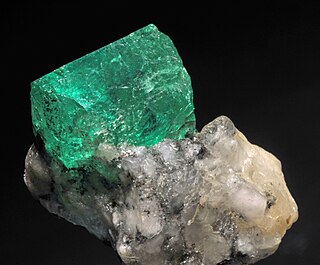
Emerald is a gemstone and a variety of the mineral beryl (Be3Al2(SiO3)6) colored green by trace amounts of chromium or sometimes vanadium. Beryl has a hardness of 7.5–8 on the Mohs scale. Most emeralds are highly included, so their toughness (resistance to breakage) is classified as generally poor. Emerald is a cyclosilicate.

A gemstone is a piece of mineral crystal which, in cut and polished form, is used to make jewelry or other adornments. However, certain rocks and occasionally organic materials that are not minerals are also used for jewelry and are therefore often considered to be gemstones as well. Most gemstones are hard, but some soft minerals are used in jewelry because of their luster or other physical properties that have aesthetic value. Rarity and notoriety are other characteristics that lend value to gemstones.

Sapphire is a precious gemstone, a variety of the mineral corundum, consisting of aluminium oxide (α-Al2O3) with trace amounts of elements such as iron, titanium, chromium, vanadium, or magnesium. The name sapphire is derived via the Latin "sapphirus" from the Greek "sappheiros", which referred to lapis lazuli. It is typically blue, but natural "fancy" sapphires also occur in yellow, purple, orange, and green colors; "parti sapphires" show two or more colors. Red corundum stones also occur, but are called rubies rather than sapphires. Pink-colored corundum may be classified either as ruby or sapphire depending on locale. Commonly, natural sapphires are cut and polished into gemstones and worn in jewelry. They also may be created synthetically in laboratories for industrial or decorative purposes in large crystal boules. Because of the remarkable hardness of sapphires – 9 on the Mohs scale (the third hardest mineral, after diamond at 10 and moissanite at 9.5) – sapphires are also used in some non-ornamental applications, such as infrared optical components, high-durability windows, wristwatch crystals and movement bearings, and very thin electronic wafers, which are used as the insulating substrates of special-purpose solid-state electronics such as integrated circuits and GaN-based blue LEDs. Sapphire is the birthstone for September and the gem of the 45th anniversary. A sapphire jubilee occurs after 65 years.
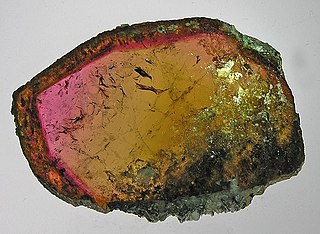
Tourmaline is a crystalline silicate mineral group in which boron is compounded with elements such as aluminium, iron, magnesium, sodium, lithium, or potassium. Tourmaline is a gemstone and can be found in a wide variety of colors.

Tanzanite is the blue and violet variety of the mineral zoisite, caused by small amounts of vanadium. Tanzanite belongs to the epidote mineral group. Tanzanite is only found in Simanjiro District of Manyara Region in Tanzania, in a very small mining area near the Mererani Hills.

The Argyle Diamond Mine was a diamond mine located in the East Kimberley region in the remote north of Western Australia. Argyle was at times the largest diamond producer in the world by volume, although the proportion of gem-quality diamonds was low. It was the only known significant source of pink and red diamonds, and additionally provided a large proportion of other naturally coloured diamonds, including champagne, cognac and rare blue diamonds.
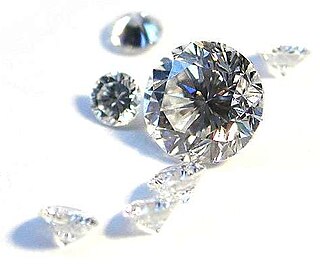
A chemically pure and structurally perfect diamond is perfectly transparent with no hue, or color. However, in reality almost no gem-sized natural diamonds are absolutely perfect. The color of a diamond may be affected by chemical impurities and/or structural defects in the crystal lattice. Depending on the hue and intensity of a diamond's coloration, a diamond's color can either detract from or enhance its value. For example, most white diamonds are discounted in price when more yellow hue is detectable, while intense pink diamonds or blue diamonds can be dramatically more valuable. Of all colored diamonds, red diamonds are the rarest. The Aurora Pyramid of Hope displays a spectacular array of naturally colored diamonds, including red diamonds.

Demantoid is the green gemstone variety of the mineral andradite, a member of the garnet group of Minerals. Andradite is a calcium- and iron-rich garnet. The chemical formula is Ca3Fe2(SiO4)3 with chromium substitution as the cause of the demantoid green color. Ferric iron is the cause of the yellow in the stone.

The Gemological Institute of America (GIA) is a nonprofit institute based in Carlsbad, California. It is dedicated to research and education in the field of gemology and the jewelry arts. Founded in 1931, GIA's mission is to protect buyers and sellers of gemstones by setting and maintaining the standards used to evaluate gemstone quality. The institute does so through research, gem identification and diamond grading services and a variety of educational programs. Through its library and subject experts, GIA acts as a resource of gem and jewelry information for the trade, the public and media outlets.
The Moussaieff Red Diamond is a diamond measuring 5.11 carats with a triangular brilliant cut, rated in color as Fancy Red by the Gemological Institute of America. It is the world's largest known red diamond, the rarest of all diamond colors.
The Ocean Dream is a diamond measuring 5.51 carats, rated in color as Fancy Deep Blue-Green by the Gemological Institute of America. The Ocean Dream is the first and one of the only natural diamonds known to the GIA to possess a blue-green hue, making it one of the rarest diamonds in the world. (A blue-green colour is commonly seen in artificially enhanced diamonds, whose colour is imparted by various irradiation methods. The Ocean Dream originated in Central Africa, and is currently owned by the Cora Diamond Corporation.
The Pink Star, formerly known as the Steinmetz Pink, is a diamond weighing 59.60 carat, rated in color as Fancy Vivid Pink by the Gemological Institute of America. The Pink Star was mined by De Beers in 1999 in South Africa, and weighed 132.5 carat in the rough. The Pink Star is the largest known diamond having been rated Vivid Pink. As a result of this exceptional rarity, the Beny Steinmetz Group called Steinmetz Diamonds took a cautious 20 months to cut the Pink. It was unveiled in Monaco on 29 May 2003 in a public ceremony.
The Pumpkin Diamond is a diamond weighing 5.54 carats rated in color as Fancy Vivid Orange by the Gemological Institute of America. While this may seem small when compared to other famous diamonds, the Pumpkin Diamond is, in fact, one of the largest Fancy Vivid Oranges the GIA reports having rated and is unique compared to other orange diamonds because it is light-colored and notably intense. The Pumpkin Diamond was mined in Central African Republic and then imported into South Africa for sale, it was later cut and polished by William Goldberg, and put to auction at Sotheby's where it was bought by Ronald Winston of the House of Harry Winston for the price of $1.3 million. It is currently estimated to be valued at $3 million.
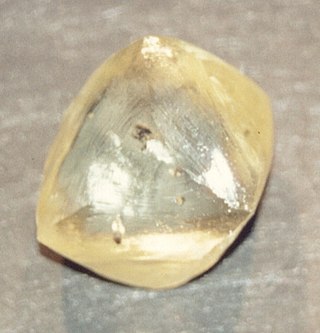
Diamonds were largely inaccessible to investors until the recent advent of regulated commodities, due to a lack of price discovery and transparency. The characteristics of individual diamonds, especially the carat weight, color and clarity, have significant impact on values, but transactions were always private. With the standardized commodity as an underlying asset, several market traded financial instruments have been announced.

Diamond is one of the best-known and most sought-after gemstones. They have been used as decorative items since ancient times.
Graff is a British multinational jeweller based in London. It was founded by British jeweller Laurence Graff in 1960. A vertically integrated company, Graff operations comprise the design, manufacture and retail distribution of jewellery and watches.
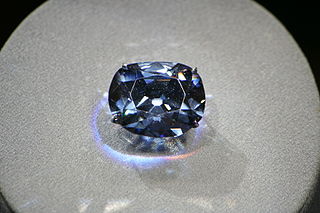
Blue diamond is a type of diamond which exhibits all of the same inherent properties of the mineral except with the additional element of blue color in the stone. They are colored blue by trace amounts of boron that contaminate the crystalline lattice structure. Blue diamonds belong to a subcategory of diamonds called fancy color diamonds, the generic name for diamonds that exhibit intense color.

Pink diamond is a type of diamond that has pink color. The source of their pink color is greatly debated in the gemological world but it is most commonly attributed to plastic deformation that these diamonds undergo during their formation.

A red diamond is a diamond which displays red colour and exhibits the same mineral properties as colourless diamonds. Red diamonds are commonly known as the most expensive and the rarest diamond colour in the world, even more so than pink or blue diamonds, as very few red diamonds have been found. Red diamonds, just like pink diamonds, are greatly debated as to the source of their colour, but the gemological community most commonly attributes both colours to gliding atoms in the diamond's structure as it undergoes enormous pressure during its formation. Red diamonds are among the 12 colours of fancy colour diamonds, and have the most expensive price per carat. They will typically run in the hundreds of thousands of dollars per carat range. Since they are the rarest colour, it is difficult to find them in large sizes, and they are mostly found in sizes less than 1 carat. Red diamonds only exist with one colour intensity, Fancy, although their clarities can range from Flawless to Included, just like white diamonds. The largest and most flawless red diamond is the 5.11 carat Fancy Red Moussaieff Red Diamond, which has internally flawless clarity.














